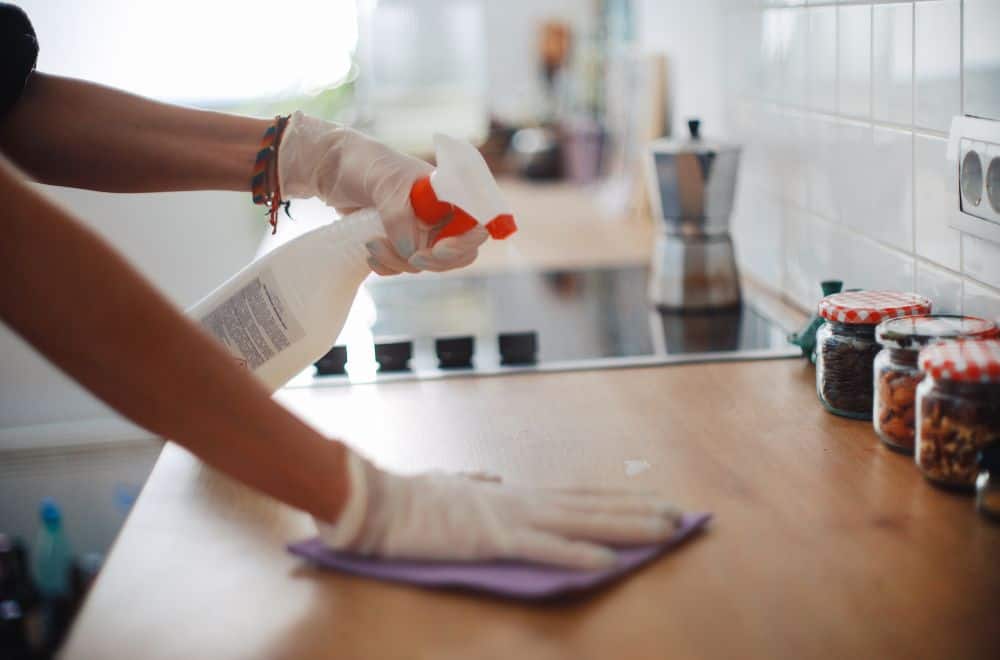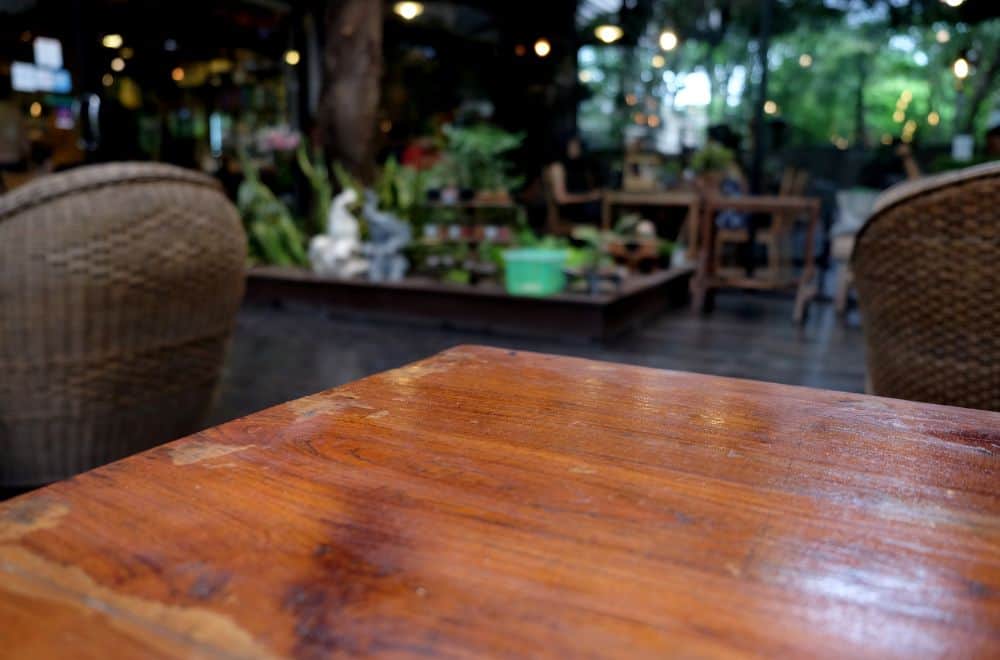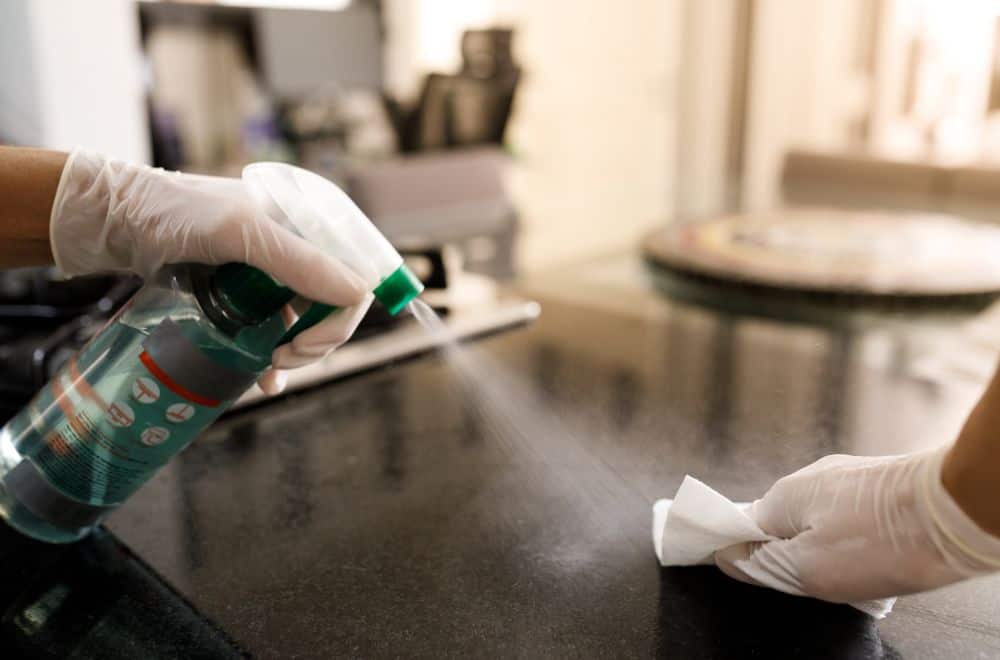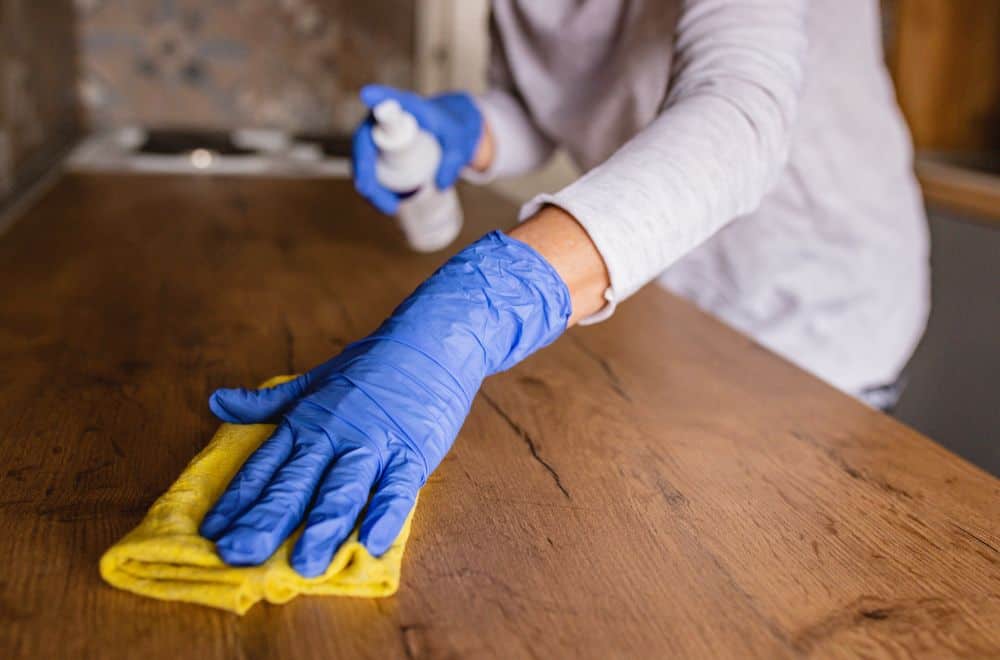
Rubbing alcohol is a popular cleaning agent that many people swear by for tackling tough stains and grime. However, when it comes to cleaning finished wood surfaces, you may be wondering if rubbing alcohol is safe and effective. After all, you don’t want to risk damaging your beautiful wood furniture or floors.
The good news is that rubbing alcohol can be a safe and effective cleaner for finished wood surfaces, as long as it is used properly. Rubbing alcohol, also known as isopropyl alcohol, is a colorless liquid that is made by combining water and propylene or ethylene. It is commonly sold at most big box stores, grocery stores, and hardware stores in concentrations ranging from 60% to 90% isopropyl alcohol and distilled water solution.
Understanding Finished Wood Surfaces

When it comes to cleaning finished wood surfaces, it’s important to understand what type of finish you are dealing with. Different finishes will react differently to cleaning agents, including rubbing alcohol. Here are some common types of finishes and how they may react to rubbing alcohol:
- Varnish: Varnish is a popular finish for wood surfaces, but it can be sensitive to rubbing alcohol. The alcohol can dissolve the varnish, leaving the wood unprotected and vulnerable to damage.
- Shellac: Shellac is another popular finish, but it is even more sensitive to rubbing alcohol than varnish. The alcohol can dissolve shellac almost instantly, leaving behind a sticky residue that is difficult to remove.
- Lacquer: Lacquer is a durable finish, but it can still be sensitive to rubbing alcohol. The alcohol can cause the lacquer to soften and become sticky, which can make it difficult to clean.
- Polyurethane: Polyurethane is a tough, durable finish that is resistant to most cleaning agents, including rubbing alcohol. However, prolonged exposure to alcohol can cause the finish to soften and become damaged.
If you are unsure what type of finish your wood surface has, it’s best to err on the side of caution and avoid using rubbing alcohol altogether. Instead, try using a mild soap and water solution or a specialized wood cleaner that is designed for your specific type of finish.
Remember, prevention is always better than cure. To avoid damaging your finished wood surfaces, take care to clean up spills and stains as soon as possible, and avoid using harsh cleaning agents or abrasive materials that can scratch or damage the finish.
What is Rubbing Alcohol?
Rubbing alcohol, also known as isopropyl alcohol, is a colorless liquid that is commonly used for cleaning and disinfecting surfaces. It is made by combining water and propylene or ethylene, and it contains approximately 70% alcohol.
Rubbing alcohol is a versatile cleaning agent that can be used for a variety of purposes, including removing stains and grime from surfaces. However, it is important to note that rubbing alcohol can be harmful to certain surfaces, particularly finished wood surfaces.
When using rubbing alcohol on finished wood surfaces, it is important to exercise caution. Rubbing alcohol can dissolve or liquefy finishes and varnishes, causing significant damage to the surface. As such, it is not recommended to use rubbing alcohol on painted, shellac, lacquered, or varnished surfaces.
Despite its potential for damage, rubbing alcohol can be an effective cleaning agent for certain types of finished wood surfaces. For example, it can be used to remove ink stains or other stubborn marks from unfinished wood surfaces.
Overall, rubbing alcohol can be a useful tool for cleaning and disinfecting surfaces, but it is important to use it with caution and to avoid using it on surfaces that may be damaged by the alcohol.
The Cleaning Properties of Rubbing Alcohol

Rubbing alcohol, also known as isopropyl alcohol, is a versatile cleaning solution that can be used on various surfaces, including finished wood. It is a popular choice for cleaning and disinfecting because it is effective against a wide range of microorganisms, including bacteria, viruses, and fungi.
When it comes to cleaning finished wood surfaces, rubbing alcohol can be an effective solution. It can help remove dirt, grime, and stains without damaging the finish. However, it is important to use it correctly to avoid any potential damage.
Here are some tips on how to use rubbing alcohol for cleaning finished wood surfaces:
- Dilute the rubbing alcohol: Pure rubbing alcohol can be too strong and can damage the finish of the wood. Dilute it with water to create a solution that is safe for use on finished wood. A ratio of 1:1 (equal parts rubbing alcohol and water) is a good starting point.
- Test on a small, inconspicuous area: Before using rubbing alcohol on a larger area, test it on a small, hidden spot to make sure it does not damage the finish.
- Apply the solution with a soft cloth: Dip a soft cloth in the rubbing alcohol solution and wring it out to remove excess liquid. Gently wipe the surface of the wood, being careful not to scrub too hard.
- Dry the surface: After cleaning, use a clean, dry cloth to wipe the surface of the wood and remove any excess moisture.
Rubbing alcohol can be a useful tool for cleaning finished wood surfaces, but it is important to use it correctly to avoid any potential damage. With the right technique, you can effectively remove dirt and stains without harming the finish of your wood furniture or flooring.
Rubbing Alcohol and Finished Wood Surfaces
When it comes to cleaning finished wood surfaces, rubbing alcohol can be a useful tool. However, it’s important to understand the potential effects it can have on your furniture. In this section, we’ll explore the chemical reaction that occurs when rubbing alcohol comes into contact with finished wood surfaces, as well as the effects it can have on the finish and wood grain.
Chemical Reaction
Rubbing alcohol, also known as isopropyl alcohol, is a solvent that can dissolve certain types of finishes, such as shellac and lacquer. When rubbing alcohol comes into contact with these finishes, it can cause them to liquefy and become sticky. This can make the finish more susceptible to damage from other cleaning products or even from something as simple as water.
Effect on Finish
If you’re cleaning a finished wood surface with rubbing alcohol, it’s important to be careful about how much you use and how you apply it. Using too much rubbing alcohol or rubbing too hard can cause the finish to become damaged or even dissolve completely. To avoid this, it’s best to use a soft cloth or sponge and to apply the rubbing alcohol in a gentle, circular motion.
Effect on Wood Grain
In addition to potentially damaging the finish, rubbing alcohol can also affect the wood grain itself. If you’re cleaning a piece of wood furniture with rubbing alcohol, it’s important to be aware that the alcohol can strip away some of the natural oils in the wood. This can cause the wood to become dry and brittle over time, which can lead to cracking or other damage.
To minimize the risk of damage to your finished wood surfaces, it’s best to use rubbing alcohol sparingly and to avoid using it on surfaces that are particularly delicate or prone to damage. If you’re unsure about whether or not rubbing alcohol is safe to use on a particular surface, it’s always a good idea to test a small, inconspicuous area first to see how it reacts.
Alternatives to Rubbing Alcohol for Cleaning Finished Wood Surfaces

If you’re looking for alternatives to rubbing alcohol for cleaning finished wood surfaces, there are a few options available. Here are some of the most effective alternatives:
Commercial Wood Cleaners
There are a variety of commercial wood cleaners available that are specifically designed for cleaning finished wood surfaces. These cleaners come in a variety of forms, including sprays, wipes, and concentrated solutions that you can dilute with water.
When choosing a commercial wood cleaner, it’s important to look for one that is specifically designed for finished wood surfaces. Some wood cleaners are designed for use on unfinished or raw wood, and may not be effective on finished surfaces.
Homemade Natural Cleaners
If you prefer to use natural cleaning solutions, there are several options that are effective for cleaning finished wood surfaces. Here are a few homemade natural cleaners that you can try:
- White Vinegar: Mix equal parts white vinegar and water in a spray bottle. Spray the solution onto the wood surface and wipe it clean with a soft cloth.
- Olive Oil and Lemon Juice: Mix 1/4 cup olive oil and 1/4 cup lemon juice in a spray bottle. Spray the solution onto the wood surface and wipe it clean with a soft cloth.
- Baking Soda and Water: Mix 1/4 cup baking soda and enough water to make a paste. Apply the paste to the wood surface and scrub it gently with a soft brush. Wipe the surface clean with a damp cloth.
When using homemade natural cleaners, it’s important to test the solution on a small, inconspicuous area of the wood surface first to ensure that it doesn’t cause any damage or discoloration.
Overall, there are several effective alternatives to rubbing alcohol for cleaning finished wood surfaces. Whether you choose a commercial wood cleaner or a homemade natural solution, be sure to follow the manufacturer’s instructions or recipe carefully to ensure the best results.
Precautions When Using Rubbing Alcohol on Finished Wood Surfaces
When using rubbing alcohol to clean finished wood surfaces, there are a few precautions you should take to avoid damaging the wood. Here are some important tips to keep in mind:
Test Patch
Before applying rubbing alcohol to a large area, it’s important to test it on a small, inconspicuous spot first. This will help you determine if the alcohol will cause any damage or discoloration to the wood. Apply a small amount of rubbing alcohol to a cotton swab or cloth and rub it gently on the test area. If there is no damage or discoloration, you can proceed with cleaning the rest of the surface.
Proper Application
When applying rubbing alcohol to a finished wood surface, it’s important to use a soft, lint-free cloth. Avoid using abrasive materials like steel wool or rough sponges, as these can scratch the surface of the wood. Apply the rubbing alcohol to the cloth, rather than directly to the wood, and use a gentle, circular motion to clean the surface.
Ventilation
Rubbing alcohol can produce fumes that can be harmful if inhaled in large quantities. To avoid breathing in these fumes, it’s important to work in a well-ventilated area. Open windows and doors to allow fresh air to circulate, and consider wearing a mask or respirator if you will be working with rubbing alcohol for an extended period of time.
By following these precautions, you can safely and effectively use rubbing alcohol to clean finished wood surfaces. Remember to always test a small area first, use a soft cloth, and work in a well-ventilated area to protect both yourself and your wood surfaces.
Regular Maintenance of Finished Wood Surfaces
If you have finished wood surfaces in your home, you know that they require regular maintenance to keep them looking their best. One of the most common questions people have is whether rubbing alcohol is an effective cleaner for finished wood surfaces.
The answer is that it depends on the type of finish you have. Most finishes will degrade or dissolve with alcohol, but some are more resistant than others and can tolerate a little bit of alcohol to clean off dirt or some adhesive. It is best to test a small, inconspicuous area before using rubbing alcohol on a larger area.
Assuming your finish can tolerate rubbing alcohol, here are some tips for regular maintenance of finished wood surfaces:
- Dust regularly: Use a soft cloth or microfiber duster to remove dust from your finished wood surfaces. Dust can scratch the surface if left to accumulate.
- Clean up spills immediately: If you spill something on your finished wood surface, clean it up immediately with a soft cloth or paper towel. Liquids can seep into the finish and cause damage if left to sit for too long.
- Use a mild cleaner: If you need to use a cleaner on your finished wood surface, use a mild cleaner that is specifically formulated for wood surfaces. Avoid using harsh chemicals or abrasive cleaners that can scratch or damage the finish.
- Avoid excessive moisture: Finished wood surfaces should be kept dry. Avoid using excessive amounts of water or leaving wet items on the surface, as this can cause the finish to warp or discolor.
- Use rubbing alcohol sparingly: If you choose to use rubbing alcohol to clean your finished wood surface, use it sparingly and only on areas that need extra cleaning. Always test a small area first to make sure the finish can tolerate it.
By following these tips for regular maintenance of your finished wood surfaces, you can keep them looking beautiful for years to come.
Frequently Asked Questions
What is the best way to clean finished wood surfaces?
The best way to clean finished wood surfaces is to use a soft cloth or sponge with a mild soap and water solution. Avoid using abrasive cleaners or harsh chemicals that can damage the wood or the finish. Always test any cleaning solution on a small, inconspicuous area of the wood before applying it to the entire surface.
Can rubbing alcohol be used to clean furniture?
Rubbing alcohol can be used to clean furniture, but it is not recommended for use on finished wood surfaces. Rubbing alcohol can dissolve or damage the finish, leaving the wood looking dull or discolored. It is best to avoid using rubbing alcohol on finished wood surfaces.
How do you disinfect finished wood?
To disinfect finished wood, use a solution of equal parts water and white vinegar. Apply the solution to the wood surface using a soft cloth or sponge, and let it sit for a few minutes. Then, wipe the surface clean with a damp cloth and dry it thoroughly.
Is rubbing alcohol safe for use on finished wood?
Rubbing alcohol is generally not safe for use on finished wood surfaces. It can damage or dissolve the finish, leaving the wood looking dull or discolored. It is best to avoid using rubbing alcohol on finished wood surfaces.
What are the effects of rubbing alcohol on polyurethane finishes?
Rubbing alcohol can damage polyurethane finishes, leaving the wood looking dull or discolored. It is best to avoid using rubbing alcohol on polyurethane finishes.
Can rubbing alcohol remove shellac from wood surfaces?
Rubbing alcohol can remove shellac from wood surfaces, but it is not recommended. Shellac is a delicate finish, and rubbing alcohol can dissolve or damage it, leaving the wood looking dull or discolored. It is best to avoid using rubbing alcohol on shellac finishes.